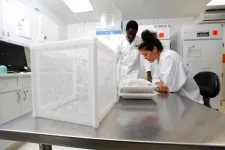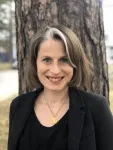(Press-News.org) When Cyclone Idai swept through Mozambique’s Gorongosa National Park in May 2019, one of nature‘s deadliest forces encountered one of the most technologically sophisticated wildlife parks on the planet. Princeton researchers and colleagues from around the world documented the effects using trail cameras and animal-tracking devices that had been in use before the storm.
Thanks to the extensive network of cameras, GPS collars and other instruments, park staff and wildlife ecologists had an “unprecedented opportunity” to assemble a minute-by-minute view of how the storm affected the park and how the animals responded, said Hallie Brown, a postdoctoral research associate in Princeton’s Department of Ecology and Environmental Biology and the first author of a new paper in Nature about the hurricane’s impact.
“This is the first study that has ever been able to track the real-time responses of a large-mammal community to a natural disaster,” said Robert Pringle, an EEB professor who has worked with Gorongosa National Park since its inception.
Brown, now a postdoctoral research associate in Pringle’s lab, was a graduate student at the time with Ryan Long, an associate professor of wildlife sciences at the University of Idaho and a former Princeton postdoc. Long and Pringle shared senior author credits on the new Nature paper.
“We watched the waters rise,” Brown recalled. “We watched the animals’ reactions in the hours, days, weeks after the cyclone: how some of them escaped the floodwaters, and some of them didn’t. We used the data we had from before, during and after the storm to create, not just a description of this one event, but a broader set of expectations, so managers can better anticipate the effects of increasingly severe weather events.”
The research team found that the best predictor of survival was size. The tiny oribi, about the size of a greyhound, saw its population plummet by 50%. About half of the slightly larger reedbucks died as well. The bushbucks, which are the smallest species that can wear a GPS collar, saw three of its eight collared animals die — the smallest male and the two smallest females — but only lost 4% of their population overall.
GPS data revealed that the bushbucks looked for hills to climb, including termite mound hillocks that reach up to 16 feet tall (5 meters) and 65 feet long (20 meters), which became islands in the flood. The researchers saw that one survivor hopscotched from mound to mound, passing quickly through the floodwaters in between, before finding safety in the woods at higher elevations. The four largest herbivores wearing GPS collars — nyala, kudu, sable and elephant — had no fatalities.
Body size also offered a secondary protection, the researchers found.
“Not only could the smaller-sized animals not outpace the waters, they were also not able to buffer the nutritional limitation afterwards,” said Brown. “Because the flood was so high for so long, it killed a lot of the grasses and low-lying vegetation. Smaller animals can’t withstand those nutritionally limited periods like larger animals, who have more fat to rely on.”
The only previous study of hurricane effects on island populations looked at lizards and spiders in the Bahamas and found very similar patterns. “It’s incredible how the patterns we found cross taxonomic and geographic lines,” said Brown. “They seem to play out the same ways in our terrestrial ecosystem, with the largest mammals on earth, and with these tiny little invertebrates and reptiles in the Bahamas.”
The researchers have two primary recommendations for other wildlife managers: evacuate the smallest and most ecologically vulnerable creatures to safer areas before storms come, and provide supplementary feed after the storm. Once all of the grasses have drowned, animals will turn to foraging on less-nutritious shrubs and bark, and many small creatures can’t survive that dietary shift.
The few carnivores in the park weathered the storm just fine, Brown said. The wild dogs and leopards benefited from having their prey animals concentrated in the upland areas, and the lions’ primary food source — warthogs — stayed in the uplands for several months but were otherwise largely unaffected by the cyclone.
The research team included institutions from five countries: Princeton University; the University of Idaho-Moscow; the University of California-Merced; Montana State University-Bozeman;Yale University; Archbold Biological Station in Venus, Florida; the University of British Columbia-Vancouver; Gorongosa National Park; the University of Kent; the University of the Witwatersrand-Johannesburg; Associação Azul Moçambique in Maputo, Mozambique.
Other Princeton authors on the paper are then-graduate students Matt Hutchinson, Ph.D. 2021; Justine Atkins Becker, Ph.D. 2020; Arjun Potter, Ph.D. 2022; and then-NSF postdoctoral fellow Meredith Palmer.
“For me, the most exciting thing about this paper is the incredible collaboration between so many groups of researchers, from hydrology to large animal ecology, to create this really integrated piece of science,” Brown said. “The best work happens in collaborative projects.”
“Trait-based sensitivity of large mammals to a catastrophic tropical cyclone,” by Reena H. Walker, Matthew C. Hutchinson, Justine A. Becker, Joshua H. Daskin, Kaitlyn M. Gaynor, Meredith S. Palmer, Dominique D. Gonçalves, Marc E. Stalmans, Jason Denlinger, Paola Bouley, Mercia Angela, Antonio Paulo, Arjun B. Potter, Nikhail Arumoogum, Francesca Parrini, Jason P. Marshal, Robert M. Pringle and Ryan A. Long, was published in Nature on Nov. 15 (DOI: 10.1038/s41586-023-06722-0). The research was supported by the U.S. National Science Foundation (IOS-1656527, DEB-2225088, IOS-1656642 and PRFB-1810586); the National Research Foundation of South Africa (116304); the Greg Carr and Cameron Schrier Foundations;; the Howard Hughes Medical Initiative BioInteractive; the Yale Institute for Biospheric Studies; the Grand Challenges Program of the High Meadows Environmental Institute at Princeton University; and the National Geographic Society (000039685).
END
Idai vs. Impalas: New study shows in real-time what helps mammals survive a natural disaster
With a network of cameras and GPS collars, Gorongosa National Park researchers watched in real time as animals reacted to Cyclone Idai, the deadliest cyclone in the southern hemisphere in recorded history.
2023-11-17
ELSE PRESS RELEASES FROM THIS DATE:
Nanoplastics promote conditions for Parkinson’s across various lab models
2023-11-17
DURHAM, N.C. – Nanoplastics interact with a particular protein that is naturally found in the brain, creating changes linked to Parkinson’s disease and some types of dementia.
In a Duke-led study appearing Nov. 17 in Science Advances, the researchers report that the findings create a foundation for a new area of investigation, fueled by the timely impact of environmental factors on human biology.
“Parkinson’s disease has been called the fastest growing neurological disorder in the world,” said principal investigator, Andrew West, Ph.D., professor in the Department of Pharmacology and Cancer Biology at ...
New research suggests plants might be able to absorb more CO2 from human activities than previously expected
2023-11-17
New research published today in leading international journal Science Advances paints an uncharacteristically upbeat picture for the planet. This is because more realistic ecological modelling suggests the world’s plants may be able to take up more atmospheric CO2 from human activities than previously predicted.
Despite this headline finding, the environmental scientists behind the research are quick to underline that this should in no way be taken to mean the world’s governments can take their foot off the brake in their obligations to reduce carbon ...
In the fight against malaria-carrying mosquitoes, just add soap
2023-11-17
EL PASO, Texas (Nov. 17, 2023) – Could the solution to the decades-long battle against malaria be as simple as soap? In a new study published in PLOS Neglected Tropical Diseases, scientists at The University of Texas at El Paso have made a compelling case for it.
The team has found that adding small quantities of liquid soap to some classes of pesticides can boost their potency by more than ten-fold.
The discovery is promising news as malaria-carrying mosquitoes display ...
Deep dive on sea level rise: new modelling gives better predictions on Antarctic ice sheet melt
2023-11-17
Using historical records from around Australia, an international team of researchers have put forward the most accurate prediction to date of past Antarctic ice sheet melt, providing a more realistic forecast of future sea level rise.
The Antarctic ice sheet is the largest block of ice on earth, containing over 30 million cubic kilometers of water.
Hence, its melting could have a devasting impact on future sea levels. To find out just how big that impact might be, the research team, including Dr Mark Hoggard from The Australian National University, turned to the past.
“If ...
Crime-free housing policies increase evictions among minorities, but do not cut crime
2023-11-17
Policies that encourage landlords to evict tenants who have involvement with the criminal justice system do not appear to reduce crime, while increasing evictions among Black residents and people with lower incomes, according to a new RAND Corporation report.
Studying “crime-free housing policies” adopted by cities in California over a decade-long period, researchers found no meaningful statistical evidence that the policies reduce crime.
The study also found that crime-free housing policies significantly increased ...
Consumption of antibiotics in the community back to pre-pandemic levels in the European Union and European Economic Area
2023-11-17
This year’s European Antibiotic Awareness Day (EAAD) focuses on the targets outlined in the 2023 Council Recommendation to step up efforts in the European Union (EU) against antimicrobial resistance in a One Health approach. [1] Those recommendations formulate the 2023 goal to reduce total antibiotic consumption (community and hospital sectors combined) by 20%, using consumption data from 2019 as baseline.
Consumption of antibiotics in the community accounts for around 90% of the total use. This means, that a substantial and consistent decline in the use of antibiotics in this sector will be key on the way towards reaching ...
LSU Health’s Bailey to receive prestigious national award
2023-11-17
New Orleans, LA – The American Psychiatric Association (APA) Foundation has selected Rahn Baily, MD, DLFAPA, ACP, Professor and Chair of Psychiatry at LSU Health New Orleans School of Medicine, as the recipient of the 2024 Solomon Carter Fuller Award.
According to the APA Foundation, “The Solomon Carter Fuller Award—established in 1969 and named for Dr. Solomon Carter Fuller, recognized as the first Black psychiatrist in America—honors a Black citizen who has pioneered in ...
Significant "post-COVID" resurgence in invasive meningococcal disease
2023-11-17
A team of scientists from the Institut Pasteur has used the database of the National Reference Center for Meningococci to trace the evolution of invasive meningococcal disease cases in France between 2015 and 2022, revealing an unprecedented resurgence in the disease after the easing of control measures imposed during the COVID-19 epidemic. Recently reported cases have mainly been caused by meningococcal serogroups that were less frequent before the pandemic, and there has been a particular uptick in cases among people aged 16 to 24. The results, published in the Journal of Infection and Public Health on October 12, ...
Scientists produce human norepinephrine neurons from stem cells, with significant implications for researching diseases like Alzheimer’s and Parkinson’s
2023-11-17
Researchers at the University of Wisconsin–Madison have identified a protein key to the development of a type of brain cell believed to play a role in disorders like Alzheimer’s and Parkinson’s diseases and used the discovery to grow the neurons from stem cells for the first time.
The stem-cell-derived norepinephrine neurons of the type found in a part of the human brain called the locus coeruleus may enable research into many psychiatric and neurodegenerative diseases and provide a tool for developing ...
Cheap medicines prevented migraine as well as expensive ones
2023-11-17
Migraine is more than just a headache. Often the pain is accompanied by nausea, vomiting, light sensitivity, and sound sensitivity. Chronic migraine can be disabling and may prevent many, especially women, from contributing to working life.
Still, it often takes a long time for migraine patients to find a treatment that works well for them. Researchers at the Norwegian Center for Headache Research (NorHead) have used data from the Norwegian Prescription Register to look at which medicines best prevent migraine in people in Norway:
“There has now been done a lot of research on this subject ...
LAST 30 PRESS RELEASES:
When is it time to jump? The boiling frog problem of AI use in physics education
Twitter data reveals partisan divide in understanding why pollen season's getting worse
AI is quick but risky for updating old software
Revolutionizing biosecurity: new multi-omics framework to transform invasive species management
From ancient herb to modern medicine: new review unveils the multi-targeted healing potential of Borago officinalis
Building a global scientific community: Biological Diversity Journal announces dual recruitment of Editorial Board and Youth Editorial Board members
Microbes that break down antibiotics help protect ecosystems under drug pollution
Smart biochar that remembers pollutants offers a new way to clean water and recycle biomass
Rice genes matter more than domestication in shaping plant microbiomes
Ticking time bomb: Some farmers report as many as 70 tick encounters over a 6-month period
Turning garden and crop waste into plastics
Scientists discover ‘platypus galaxies’ in the early universe
Seeing thyroid cancer in a new light: when AI meets label-free imaging in the operating room
Neutrophil-to-lymphocyte ratio may aid risk stratification in depressive disorder
2026 Seismological Society of America Annual Meeting
AI-powered ECG analysis offers promising path for early detection of chronic obstructive pulmonary disease, says Mount Sinai researchers
GIMM uncovers flaws in lab-grown heart cells and paves the way for improved treatments
Cracking the evolutionary code of sleep
Medications could help the aging brain cope with surgery, memory impairment
Back pain linked to worse sleep years later in men over 65, according to study
CDC urges ‘shared decision-making’ on some childhood vaccines; many unclear about what that means
New research finds that an ‘equal treatment’ approach to economic opportunity advertising can backfire
Researchers create shape-shifting, self-navigating microparticles
Science army mobilizes to map US soil microbiome
Researchers develop new tools to turn grain crops into biosensors
Do supervised consumption sites bring increased crime? Study suggests that’s a myth
New mass spec innovation could transform research
Maternal nativity, race, and ethnicity and infant mortality in the US
Migration-related trauma among asylum seekers exposed to the migrant protection protocols
Jupiter’s moon Europa has a seafloor that may be quiet and lifeless
[Press-News.org] Idai vs. Impalas: New study shows in real-time what helps mammals survive a natural disasterWith a network of cameras and GPS collars, Gorongosa National Park researchers watched in real time as animals reacted to Cyclone Idai, the deadliest cyclone in the southern hemisphere in recorded history.







